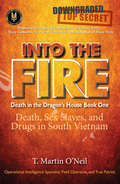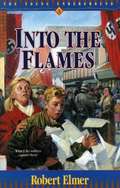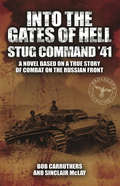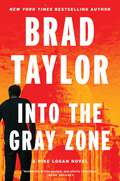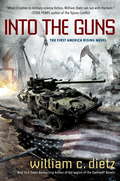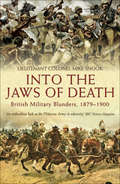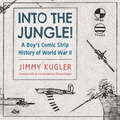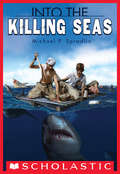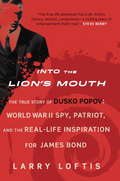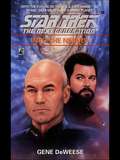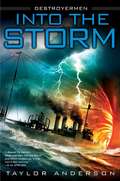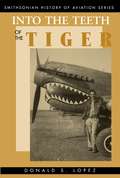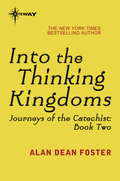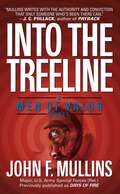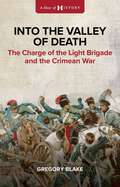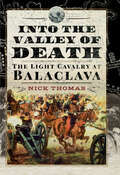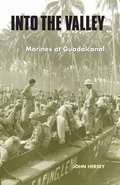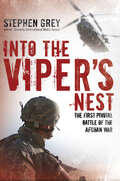- Table View
- List View
Into the Fire: Death, Sex Slaves, and Drugs in South Vietnam (Death in the Dragon’s House #1)
by T. Martin O’neilThe cover of darkness was pulled back by the NODS scopes in their hands. The enemy had no idea what was about to befall them. With the rush of wings of dragons, the sounds of M-14s, M-870 shotguns, M-16's and grenades spoke the finality of death. This gave the human pack mules a taste of what would continue to reign upon them in the House of the Dragon. North and South Vietnam were at war. Indeed, all of Southeast Asia was at war. Due to national commitments, the U.S. military was drawn into the fray. Members of the elite Navy SEALS performed operations from counter-narcotics, counter-human trafficking and even counter piracy. These men placed their lives on the line daily as true humanitarians. Seen through the eyes of attached Naval Intelligence operatives, their stories can now be revealed. These operations, specific missions, even their love stories, are recounted in Into the Fire.
Into the Flames (The Young Underground #3)
by Robert ElmerThe Nazis were after them, and there was nowhere to hide. INTO THE FLAMES. Twelve-year-old Peter and Elise Anderson have secretly taken on assignment--delivering illegal newspapers for the Danish Underground! Bringing news of freedom and deliverance to the people of Denmark seems like the perfect way to help fight the Nazis--until soldiers nearly sabotage their mission. Is class troublemaker Keld Poulsen spying on Peter and Elise? Will he report them to the Nazis? Armed with secret code names, Peter and Elise must elude Keld in spite of his threats. When the Nazis plot to raid newspaper headquarters, the twins rush to help their friends in the Underground--but will they find themselves cornered by German soldiers?
Into the Gates of Hell: A Novel Based on a True Story of Combat on the Russian Front
by Bob Carruthers Sinclair McLay03:15, 22nd June 1941 - Barbarossa is unleashed and Kampfgruppe von Schroif are right there at the cutting edge of the battle for Russia. Thrown into action against the fortress of Brest-Litovsk, von Schroif and his crew drive a new weapon into battle - the legendary Sturmgeschtz. However, even with this latest armoured marvel there is hard fighting as the Reds dig in and doggedly defend the island fortress to the last man.rnrnPenetrating , authentic and stunning in its detail, the long awaited prequel to the highly acclaimed 'Tiger Command!' is a powerful addition to the series. Based on a true story of combat on the Eastern Front, this atmospheric new novel puts the reader right into the action and unveils the story of how a legend was forged in the heat of the first great battle of the campaign.rnrnWritten by Emmy AwardTM winning writer Bob Carruthers and newcomer Sinclair McLay and edited by Mark Farr, this much anticipated Eastern Front novel also explores the dark underside of war as von Schroif is faced with the malevolent presence of Oskar Dirlewanger.
Into the Gray Zone: A Pike Logan Novel (Pike Logan #19)
by Brad TaylorNEW YORK TIMES BESTSELLER“A knockout punch of a novel.” —Mark GreaneyPike Logan uncovers a geopolitical scheme that has spiraled out of control in India in this latest pulse-pounding thriller with ripped from the headlines themes from New York Times bestselling author and former special forces officer Brad Taylor. While on a routine security assessment in India, Taskforce operator Pike Logan foils an attempted attack on a meeting between the CIA and India’s intelligence service. Both government agencies believe it’s nothing more than a minor terrorist attack, but Pike suspects that something much more sinister is at play. After another terrorist operation at the Taj Mahal, he begins to believe that outside powers are attacking India in the gray zone between peace and war, part of a proxy war that leverages terrorist groups for economic gain and control of rare earth minerals. But the separatists conducting the operations have their own agenda.After a massive slaughter and kidnapping of hostages during an elaborate Indian pre-wedding party, two global powers are destabilized, and only Pike Logan and his team can de-escalate the tension by rescuing the captives. What follows is a race against the clock that winds through the bustling markets of Old Delhi, the luxurious resorts of Goa, and the epic halls of the Taj Mahal. It will take everything that Logan and the taskforce have to foil an intricate plot that leaves countless lives in the balance."Diligent spycraft, throat-clutching suspense, and military action that rips straight off the page. And this outing shows how political gamesmanship operates deep in the shadows, where nothing is black and white, only shades of gray." — James Rollins, #1 New York Times bestselling author of Arkangel
Into the Guns
by William C. DietzFrom the New York Times bestselling author of The Legion of the Damned® Novels and The Mutant Files comes the first novel in a post-apocalyptic military science fiction series about America rising from the ashes of a global catastrophe...On May Day, 2018, sixty meteors entered Earth's atmosphere and exploded around the globe with a force greater than a nuclear blast. Earthquakes and tsunamis followed. Then China attacked Europe, Asia, and the United States in the belief the disaster was an act of war. Washington D.C. was a casualty of the meteor onslaught that decimated the nation's leadership and left the surviving elements of the armed forces to try and restore order as American society fell apart. As refugees across America band together and engage in open warfare with the military over scarce resources, a select group of individuals representing the surviving corporate structure makes a power play to rebuild the country in a free market image as The New Confederacy...From the Hardcover edition.
Into the Jaws of Death: British Military Blunders, 1879–1900
by Mike SnookBetween the Crimean War and the dawn of the 20th century, the British Army was almost continuously engaged in one corner of the globe or another, in military operations famously characterized by Kipling as the 'savage wars of peace'. In his new work on the most dramatic Victorian campaigns Mike Snook bring's the most dramatic clashes of the age of empire back to life. Here focuses closely on defeat and disaster—the occasions when things went badly awry for the British. The names of these great battles—Isandlwana, Maiwand, Majuba Hill, Khartoum, Colenso, Spion Kop and Magersfontein still resonate down through the ages. In a meticulously researched military history, the author exposes the true and sometimes embarrassing causes of defeat. Overstretch, political meddling, military incompetence and petty jealousy all played their part. Above all else, however, these are dramatic and perceptive accounts of mere mortal men struggling to deal with the often overpowering dynamics and horrors of 19th-century warfare on the fringes of Empire.
Into the Jungle!: A Boy's Comic Strip History of World War II (Cultures of Childhood)
by Jimmy KuglerNear the end of World War II and after, a small-town Nebraska youth, Jimmy Kugler, drew more than a hundred double-sided sheets of comic strip stories. Over half of these six-panel tales retold the Pacific War as fought by “Frogs” and “Toads,” humanoid creatures brutally committed to a kill-or-be-killed struggle. The history of American youth depends primarily on adult reminiscences of their own childhoods, adult testimony to the lives of youth around them, or surmises based on at best a few creative artifacts. The survival then of such a large collection of adolescent comic strips from America’s small-town Midwest is remarkable. Michael Kugler reproduces the never-before-published comics of his father’s adolescent imagination as a microhistory of American youth in that formative era. Also included in Into the Jungle! A Boy's Comic Strip History of World War II are the likely comic book models for these stories and inspiration from news coverage in newspapers, radio, movies, and newsreels. Kugler emphasizes how US propaganda intended to inspire patriotic support for the war gave this young artist a license for his imagined violence. In a context of progressive American educational reform, these violent comic stories, often in settings modeled on the artist’s small Nebraska town, suggests a form of adolescent rebellion against moral conventions consistent with comic art’s reputation for “outsider” or countercultural expressions. Kugler also argues that these comics provide evidence for the transition in American taste from war stories to the horror comics of the late 1940s and early 1950s. Kugler’s thorough analysis of his father’s adolescent art explains how a small-town boy from the plains distilled the popular culture of his day for an imagined war he could fight on his audacious, even shocking terms.
Into the Killing Seas
by Michael P. Spradlin"When the ship goes down, the sharks come out.... Stranded in the war torn Pacific, Patrick and his younger brother Teddy are finally homeward-bound. They've stowed away on one of the US Navy's finest ships, and now they just need to stay hidden. But Japanese torpedoes rip their dream apart. And the sinking ship isn't the worst of it. Patrick and Teddy can handle hunger and dehydration as they float in the water and wait to be rescued. If they're smart, they can even deal with the madness that seems to plague their fellow survivors. No, the real danger circles beneath the surface. And it has teeth.... Based on the true events of the 1945 sinking of the USS Indianapolis, author Michael P. Spradlin tells a harrowing story of World War II."
Into the Lion's Mouth: World War II Spy, Patriot, and the Real-Life Inspiration for James Bond
by Larry LoftisJames Bond has nothing on Dusko Popov. a double agent for the Abwehr, MI5 and MI6, and the FBI during World War II, Popov seduced numerous women, spoke five languages, and was a crack shot, all while maintaining his cover as a Yugoslavian diplomat... On a cool August evening in 1941, a Serbian playboy created a stir at Casino Estoril in Portugal by throwing down an outrageously large baccarat bet to humiliate his opponent. The Serbian was a British double agent, and the money-which he had just stolen from the Germans-belonged to the British. From the sideline, watching with intent interest was none other than Ian Fleming... The Serbian was Dusko Popov. As a youngster, he was expelled from his London prep school. Years later he would be arrested and banished from Germany for making derogatory statements about the Third Reich. When World War II ensued, the playboy became a spy, eventually serving three dangerous masters: the Abwehr, MI5 and MI6, and the FBI. On August 10, 1941, the Germans sent Popov to the United States to construct a spy network and gather information on Pearl Harbor. The FBI ignored his German questionnaire, but J. Edgar Hoover succeeded in blowing his cover. While MI5 desperately needed Popov to deceive the Abwehr about the D-Day invasion, they assured him that a return to the German Secret Service Headquarters in Lisbon would result in torture and execution. He went anyway... Into the Lion's Mouth is a globe-trotting account of a man's entanglement with espionage, murder, assassins, and lovers-including enemy spies and a Hollywood starlet. It is a story of subterfuge and seduction, patriotism, and cold-blooded courage. It is the story of Dusko Popov-the inspiration for James Bond. INCLUDES PHOTOGRAPHSFrom the Hardcover edition.
Into the Nebula: Into the Nebula (Star Trek: The Next Generation #36)
by Gene DeWeeseThe members of the Starship Enterprise™ must find the people responsible for destroying the planet before an entire civilization dies out.While exploring an unknown region of space, the U.S.S. Enterprise™ encounters a strange nebular dust. Upon further investigation, they discover a planet called Krantin on which the plant and animal life, as well as the civilization are dying. A series of explosions and a ship that simply disappears into thin air lead the crew to believe another group is causing the devastation of the planet. The leader of the planet's society, however, is wary of trusting the Starship Enterprise™ crewmembers, and has the away team arrested. With time running out, Data must find a way to save his crewmates or watch as two worlds are destroyed.
Into the Night: Troubleshooters 5 (Troubleshooters #5)
by Suzanne BrockmannTroubleshooters: They Never Let You Down. The fifth addictive romantic suspense novel in New York Times bestselling author Suzanne Brockmann's Troubleshooters series, filled with thrilling adventure, excitement and passion. In INTO THE NIGHT, as a deadly assassination plot plays out around them, White House staffer Joan DaCosta and Lieutenant Mike Muldoon must risk everything to survive.When White House staffer Joan DaCosta is assigned to work with Navy SEAL Lieutenant Mike Muldoon on a presidential visit to a Californian naval base, she is reluctant to admit quite how drawn she is to the handsome young officer. For a woman who has always prided herself on being 'one of the guys' in the mostly male-dominated world of politics, it's stunning to her how quickly Mike breaks through her defences. Mike may be younger than Joan in years, but his experience in the field has made him strong, decisive and fearless - he's more than a match for Joan. But as their attraction grows, so does a terrible danger: terrorists are plotting to attack the president. Now, Joan and Mike must risk their lives and everything they hold dear, including their hearts, if they are to save their commander-in-chief from the disaster that awaits him...
Into the Rising Sun: In Their Own Words, World War II's Pacific Veteran
by Patrick K. O'Donnell"Iwo Jima was a massacre. I never expected anything like that. People were dying left and right...No names should have been used on the flag raisings because we didn't get up there by ourselves. It was the collective actions of a lot of people and there were a lot of Raiders and paratroopers up there with us." -- Charles Lindberg, Flag RaiserPatrick O'Donnell has made a career of uncovering the hidden history of World War II by tracking down and interviewing its most elite troops: the Rangers, Airborne, Marines, and First Special Service Force, forerunners to America's Special Forces. These men saw the worst of the war's action, and most of them have been reluctant to talk about it. With O'Donnell's respectful coaxing, however, they first began telling their stories through www.thedropzone.org, his award-winning Web site. In 2001, veterans of the European Theater told their stories in O'Donnell's first book, Beyond Valor. Now, in Into the Rising Sun, O'Donnell presents scores of veterans' personal accounts, based on over a thousand interviews spanning the past ten years, to tell the story of the brutal Pacific war."They were making a lot of noise, talking, yelling to one another, and I heard someone getting beat up on the left. I can still hear the screams. He was begging for mercy. They [the Japanese] were berating him. Later on I found that it was one of my friends, Ken Ritter." -- Robert Youngdeer, GuadalcanalThese veterans were often the first in and the last out of every conflict, from Guadalcanal and Burma to the Philippines and the black sands of Iwo Jima. They faced a cruel enemy willing to try anything, including kamikaze flights and human-guided torpedoes. As O'Donnell explains in the Introduction, most of the men in this book were at first reticent to talk. Over the course of the war, they had spearheaded D-Day-sized beach assaults, encountered cannibalism, suffered friendly-fire incidents, and endured torture as pris-oners of war. Heroes among heroes, they include many recipients of the Navy Cross, the Distinguished Service Cross, the Silver Star, and other medals of battlefield valor, but none bragged about it. As one soldier put it, "When somebody gets decorated, it's because a lot of other men died." By at last telling their stories, these men present an unvarnished look at the war on the ground, a final gift from aging warriors who have already given so much. Only with these accounts can the true horror of the war in the Pacific be fully known. O'Donnell has carefully verified each account by comparing it with official records and interviews, and he intersperses each story with brief commentary. Together with detailed maps of each battle, the veterans' stories in Into the Rising Sun offer nothing less than a complete picture of the war in the Pacific, a ground-level view of some of history's most brutal combat.
Into the Storm
by Lisa BinghamA romantic epic of World War II London by &“a master storyteller&” (Affaire de Coeur). It takes just twenty-four hours for RueAnn Boggs to be swept off her feet by Charles Tolliver, a handsome Brit with a secret job, and after she marries him, the dashing Charlie hastily departs for an assignment in England. When weeks go by and she hears nothing from her new husband, RueAnn becomes determined to find out if she&’s a wife in name only, and travels to London for answers. But what she discovers is not what she expects. Susan Blunt has spent her life staying put, retreating into her books while her vivacious twin sister, Sara, lives life to the fullest. Sara has collected a throng of beaus in uniform, including an RAF pilot headed for the front. When Sara pressures Susan into switching places and going to a dance with him, Susan reluctantly agrees—and in the course of the night, quickly falls in love. When the Blitz begins and bombs start raining down on London, both RueAnn and Susan must find the strength and courage they never knew they had in order to survive. They form a friendship out of the city&’s ashes, one that helps them weather the storm as they wait for news from the front—from the men they love, have lost, and hope desperately to find once more . . .
Into the Storm (Destroyermen, Book #1)
by Taylor AndersonANOTHER WORLD, ANOTHER WAR ... Pressed into service in World War II, USS Walker--a Great War-era destroyer--finds itself in full retreat from pursuit by Japanese battleships. Its captain, Lieutenant Commander Matthew Patrick Reddy, heads Walker into a squall for cover. They emerge somewhere else .... Familiar landmarks appear, but the water teems with vicious, monstrous fish--and there appear to be dinosaurs grazing onshore. Matt and his crew have entered an alternate world--and they are not alone. Humans have not evolved, but two other species have. And they are at war. With its weaponry, Walker could tip the balance of power. Matt and his crew must decide which species they will support, because the side they choose will be victorious ....
Into the Sun: A Novel
by Deni Ellis Béchard<P>When a car explodes in a crowded part of Kabul ten years after 9/11, a Japanese-American journalist is shocked to discover that the passengers were acquaintances-three fellow ex-pats who had formed an unlikely love triangle. <P>Alexandra was a human rights lawyer for imprisoned Afghan women. Justin was a born-again Christian who taught at a local school. Clay was an ex-soldier who worked as a private contractor. The car's driver, Idris, was one of Justin's most promising pupils-and he is missing. <P>Drawn to the secrets of these strangers, and increasingly convinced the events that led to the fatal explosion weren't random, the journalist follows a trail that leads from Kabul to Louisiana, Maine, Québec, and Dubai. In the process, the tortured narratives of these individuals become inseparable from the larger story of America's imperial misadventures. <P>In this monumental novel, Deni Ellis Béchard draws an unsentimental portrait of those who flock to warzones, indelibly capturing these journalists, mercenaries, idealists, and aid workers. More importantly, Béchard vividly brings to life the city of Kabul itself, along with the people who live there: the hungry, determined, and resourceful locals who are just as willing as their occupiers to reinvent themselves to survive.
Into the Teeth of the Tiger
by Donald S. LopezInto the Teeth of the Tiger provides a vivid, pilot's-eye view of one of the most extended projections of American air power in World War II Asia. Lopez chronicles every aspect of fighter combat in that theater: harrowing aerial battles, interludes of boredom and inactivity, instances of courage and cowardice. Describing different pilots' roles in each type of mission, the operation of the P-40, and the use of various weapons, he tells how he and his fellow pilots faced not only constant danger but also the munitions shortages, poor food, and rat-infested barracks of a remote sector of the war. The author also offers keen observations of wartime China, from the brutalities of the Japanese occupation to the conflict between Chiang Kai-shek's Nationalists and the Communist movement.This edition of Lopez's acclaimed account features new photographs, most of which have never before been published. Relating how the 23rd Fighter Group continued to win battles even as the Japanese gained ground, Into the Teeth of the Tiger is the humorous and insightful memoir of an ace pilot caught in the paradox of victory in retreat.From the Trade Paperback edition.
Into the Thinking Kingdoms
by Alan Dean FosterAejole Ehomba has led his companions through jungle, veldt, and desert. Now to reach the fabled port of Hamacassar, the simple herdsman must trek through deadly "civilized" lands where flowers wage war, dogs herd lightning, demons govern the darkness, and Time itself can be held captive. In this new world, the tribesman must rely upon his friends, wondrous weapons, and the magic of memories so potent they can raise the dead or bring the sea to dry land. But no matter where he goes, every seer and sage Ehomba mets offes the same prophecy: his quest will end in failure ...and death.
Into the Tiger's Jaw
by Frank E. Peterson Jr. J. Alfred PhelpsLt. General Frank E. Petersen's autobiography provides a critical examination of this remarkable Marine's career, from his accomplishments as the first black pilot in the U.S. Marine Corps to his promotion to Lieutenant General and final service as Commander U.S. Marine Corp Base Quantico, Virginia. At the time of his retirement in 1988, General Petersen was the first and only black pilot to hold command and the only black general in the Marine Corps. A new addition to the Leatherneck Classics series, this story of great personal determination and impressive leadership provides a clear understanding of an inspirational path to success in the military
Into the Treeline: A Men of Valor Novel (Men of Valor #2)
by John F. MullinsSpecial Forces veteran John F. Mullins continues his series of men at war with a story of explosive action and unrelenting drama -- from the home front to the front lines.... When Lieutenant James "No-Middle-Initial" Carmichael is wounded in the Central Highlands of Vietnam, he is medevacked to the U.S. and nursed back to health by a young medic with whom he falls in love. After two tours, he knows he could ask to be stationed Stateside -- but he has unfinished business in Nam. Back in-country, Carmichael joins the covert Phoenix Program, where his mission is to take out the Viet Cong high command. He proves himself so lethal that the enemy places a price on his head. The Cong are not his only foes. His South Vietnamese "allies" betray him at every turn, even as he begins to doubt his own motives and honor. But when an ultimate act of treachery from within leaves him abandoned and surrounded, Jim Carmichael has only one choice.... Fight or die.
Into the Valley of Death: The Charge of the Light Brigade and the Crimean War
by Gregory Blake&‘Cannon to the right of them, Cannon to the left of them, Cannon in front of them, Volleyed and thundered; Stormed at with shot and shell. Boldly they rode and well, Into the jaws of Death, Into the mouth of hell, Rode the six hundred.&’ — Alfred Lord Tennyson.Into the Valley of Death brings to life the story behind Tennyson's immortal lines: &“Into the valley of Death rode the six hundred.&” In 1854, 670 British cavalrymen, following a disastrous command, charged into history&’s most celebrated—and tragic—act of bravery. The Crimean War marked a turning point in military history, introducing war photography, frontline journalism, and modern medicine. It was a time when outdated military strategy clashed with emerging technologies, leading to immense suffering for the common soldier. This book explores the battles, personalities, and technological shifts that transformed warfare. Combining personal letters, battle accounts, and insightful analysis, Into the Valley of Death uncovers the causes of the war, the complex alliances, and the military culture that shaped the Charge of the Light Brigade. Through insights from historians like Anthony Dawson, John Grehan, and Terry Brighton, Into the Valley of Death sheds new light on the courage, chaos, and legacy of the Crimean War. Part of the Shot of History series, this book transforms complex events into captivating, easy-to-read narratives, making history both engaging and unforgettable.
Into the Valley of Death: The Light Cavalry at Balaclava
by Nick ThomasUnique work that details the status of each man known to have taken an active part in the Charge, listing the evidence supporting their case for inclusion among the ranks of the immortal Light Cavalry Brigade.Into the Valley of Death tells the thrilling story of the Charge of the Light Brigade in the words of the men who fought during the most heroic and yet futile engagement of the modern era. By drawing on key evidence the author has not only provided a clear narrative of the events leading up to the 25th October 1854, but has painted a vivid picture of the Charge itself. No punches are pulled and the carnage which ensued is clear for all to read, dispelling the romantic myth of ‘death or glory’ fostered by the Victorians. This work tells the blood and guts story of a desperate charge by 673 men in the face of what seemed insurmountable odds. It reveals the trauma endured by the rank and file who witnessed all around them men and horses cut to pieces while endeavoring to ride through walls of flying iron and lead, and not knowing if the next second would be their last. Yet in the midst of this horror and devastation, the author takes time to give an overview of the battle itself and puts on the hats of some of the commanders involved, looking at not only what they did, but also at how a terrible disaster could so easily have been turned into the greatest single victory of its time. Could such an apparently mad-cap charge have succeeded? Did sufficient men arrive at the guns to successfully capture them? Were there troops and close support that could have been utilized to drastically change the course of events? Could a simple stalling tactic have allowed these resources to have been fully exploited? All of these questions are answered. This work truly lifts the lid on the events of over 150 years ago and through the words of the survivors allows the reader to assign the responsibility for the Charge having taken place and for the consequent loss of the Light Brigade.
Into the Valley: Marines at Guadalcanal
by John HerseyHersey gives insightful details concerning the jungle environment, recounts conversations among the men before, during, and after the battle at Guadalcanal, and describes how the wounded were evacuated as well as other works of daily heroism.
Into the Viper's Nest: The First Pivotal Battle of the Afghan War
by Stephen GreyThis gripping account of the Afghan War details the dramatic three-day battle for the Taliban stronghold of Musa Qala in 2007.With a pre-battle population of fifteen to twenty thousand, Musa Qala was the only significant town held by the Taliban at that time. Attacking against two thousand Taliban fighters, who had been occupying the town for more than nine months, the International Security Assistance Force (ISAF) was spearheaded by Task Force 1 Fury: 1st Battalion, 508th Parachute Infantry Regiment, of the 82nd Airborne Division.For the ISAF, Musa Qala was a target of immense importance. The Taliban had to be driven out and the town secured. But the Taliban were well prepared to stand and fight. What resulted was one of the biggest and most terrible battles of the war.
Into the Void (Star Trek: The Next Generation #2)
by Peter DavidRoll Call: The Crew of the U.S.S. Excalibur: Captain Mackenzie Calhoun: An unorthodox, decisive young captain who loves his crew and his ship, and loves testing their limits even more. Commander Shelby: A woman of strong opinions and strong values, Shelby never hesitated to tell her captains when she thought they were wrong, and Mackenzie Calhoun won't be any exception. Burgoyne 172: The chief engineer of the Excalibur, with the decisiveness of Calhoun, the strength of Shelby, and the gender of both. Burgoyne is a Hermat, and when s/he sets his/her sights on you, s/he isn't an easy...person...to refuse. As the Thallonian Empire succumbs to violence and insurrection, the U.S.S. Excalibur prepares to launch on her humanitarian mission of mercy. But her departure is destined to be a memorable one, as Calhoun contends with an unexpected stowaway, a stormy relationship with his crew, and -- light-years away -- frightened refugees aboard a dying ship.
Into the Wilderness, America West Series Book 1
by Rosanne BittnerWhen sixteen-year-old Jessica Matthews is attacked by Ottawa Indians, she is saved by the darkly attractive long hunter Noah Wilde. As Noah recovers from his wounds at Jessica's mountain cabin, he and Jessica fall in love; but Noah, who is secretly spying for the English government, has a mission to fulfill and is forced to leave once he recovers. When Noah is unexpectedly detained in Virginia, a tragedy changes Jessica's life forever. He must use all of his investigative skills to find the woman he loves. But whether she will take him back--and whether her new family will allow her to be taken--remains to be seen.
